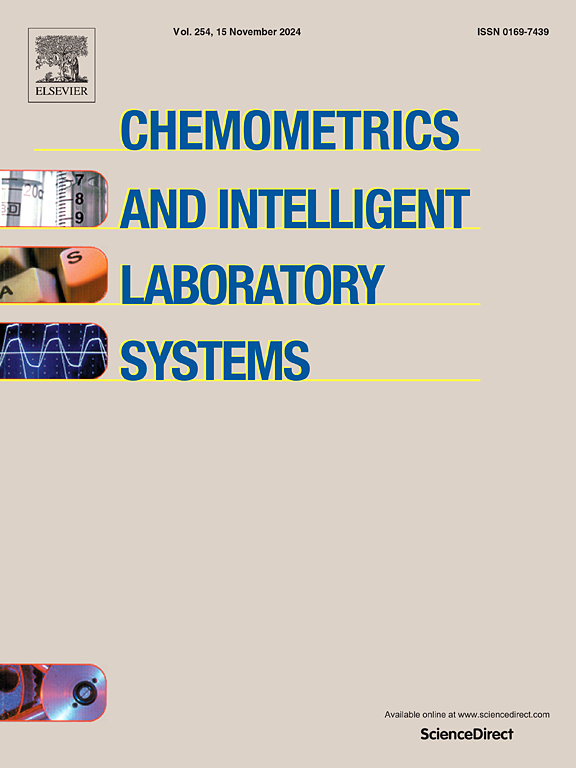A likelihood ratio model for three-way data coupled with a Tucker3 model
IF 3.8
2区 化学
Q2 AUTOMATION & CONTROL SYSTEMS
Chemometrics and Intelligent Laboratory Systems
Pub Date : 2025-06-24
DOI:10.1016/j.chemolab.2025.105464
引用次数: 0
Abstract
In forensic science, the analysis of diesel fuel is particularly important in fire investigations. The task is usually to compare the original accelerant found among the suspect’s belongings with the fire debris to find out if the fire could have been caused by the use of that particular diesel fuel (called source). The major problem when comparing the original accelerant with the fire debris is the weathering process of the accelerant taking place during the fire. The weathering process makes the composition of the accelerant change with the weathering state and may differ from the composition of the original accelerant. In this context the question arises if samples of the fire debris containing the accelerant weathered to different degrees are still so similar to the original accelerant that they can be regarded as coming from the same source (this particular accelerant) and whether samples of fire debris with accelerants from different sources are easily identified as such regardless of their weathering state. The hybrid likelihood ratio (LR) model which takes into account the information about the similarity and the frequency of observing the compared features in the samples was used for answering the above issues. Hybrid LR models use the new set of a limited number of variables that is generated using a variety of chemometric tools to summarise the data as well as possible and highlight the features that make each source of samples uniquely defined. The model was built for three-way GC–MS data of diesel fuel samples. Tucker3 model decomposed the three-dimensional array of the database into three matrices referring to GC, MS and samples (concentration) modes. The scores on the linear discriminant functions for the concentration mode served as an input for LR models. True origins for the majority of samples were indicated despite different weathering.
三向数据的似然比模型与Tucker3模型相结合
在法医学中,柴油分析在火灾调查中尤为重要。任务通常是将在嫌疑人物品中发现的原始助燃剂与火灾残骸进行比较,以确定火灾是否可能是由使用特定的柴油燃料(称为源)引起的。将原助燃剂与火灾碎屑进行比较时,主要问题是助燃剂在火灾中发生的风化过程。风化过程使促进剂的成分随风化状态的变化而变化,可能与原促进剂的成分不同。在这种情况下,问题出现了,如果含有不同程度风化的促进剂的火灾碎片样本仍然与原始促进剂如此相似,以至于它们可以被视为来自同一来源(这种特定的促进剂),以及来自不同来源的促进剂的火灾碎片样本是否很容易被识别出来,而不管它们的风化状态如何。混合似然比(LR)模型考虑了样本中比较特征的相似性和观察频率的信息,用于回答上述问题。混合LR模型使用使用各种化学计量工具生成的有限数量的新变量集来总结数据,并尽可能突出使每个样本来源具有独特定义的特征。针对柴油样品的三向GC-MS数据建立了模型。Tucker3模型将数据库的三维阵列分解为GC、MS和样品(浓度)模式三个矩阵。浓度模式的线性判别函数得分作为LR模型的输入。尽管风化情况不同,但大多数样品的真实来源都得到了说明。
本文章由计算机程序翻译,如有差异,请以英文原文为准。
求助全文
约1分钟内获得全文
求助全文
来源期刊
CiteScore
7.50
自引率
7.70%
发文量
169
审稿时长
3.4 months
期刊介绍:
Chemometrics and Intelligent Laboratory Systems publishes original research papers, short communications, reviews, tutorials and Original Software Publications reporting on development of novel statistical, mathematical, or computer techniques in Chemistry and related disciplines.
Chemometrics is the chemical discipline that uses mathematical and statistical methods to design or select optimal procedures and experiments, and to provide maximum chemical information by analysing chemical data.
The journal deals with the following topics:
1) Development of new statistical, mathematical and chemometrical methods for Chemistry and related fields (Environmental Chemistry, Biochemistry, Toxicology, System Biology, -Omics, etc.)
2) Novel applications of chemometrics to all branches of Chemistry and related fields (typical domains of interest are: process data analysis, experimental design, data mining, signal processing, supervised modelling, decision making, robust statistics, mixture analysis, multivariate calibration etc.) Routine applications of established chemometrical techniques will not be considered.
3) Development of new software that provides novel tools or truly advances the use of chemometrical methods.
4) Well characterized data sets to test performance for the new methods and software.
The journal complies with International Committee of Medical Journal Editors'' Uniform requirements for manuscripts.

 求助内容:
求助内容: 应助结果提醒方式:
应助结果提醒方式:


